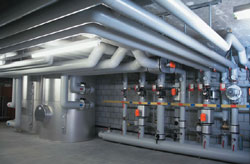



The Relevance of Hatchery Climate Control
While optimising climate inside the incubator best supports the needs of growing embryos, accurate climate control elsewhere in the hatchery also makes an important contribution to overall efficiency, writes Derk Pijnenburg of Pas Reform. |
Growing embryos use oxygen and produce carbon dioxide and water vapour during incubation, thus the air within the incubator needs to be refreshed regularly. However, to maintain truly efficient climate control, there are other important factors to consider, including temperature and relative humidity in the various rooms of the hatchery, the avoidance of airborne cross-contamination and energy saving.
Homogeneous incubation temperature is best achieved when the machines operate in an area where temperature and humidity are constantly maintained. Maximum room temperature is reduced when the incubator depends partially on air cooling - and in this case, a greater volume of air will be required than when using a water-cooled system, to cater for both the oxygen needs of the embryos and the cooling requirement of the incubators.
Similarly, it is useful to humidify inlet air. This avoids the creation of ‘cold spots’, which arise with the constant operation of a humidifier in the incubator: particularly relevant for hatcheries in dry and/or cold regions. Conversely, hatcheries in hot, humid countries can benefit from dehumidifying inlet air, so avoiding overly high humidity in the setter - which results in insufficient weight loss by the hatching eggs during incubation.
Air transport by natural ventilation substantially limits the hatchery’s control of temperature and humidity. An air handling unit (AHU) enables inlet air to be conditioned and regulated, based on the needs of the embryos. This is achieved by controlling the output of the AHU according to the pressure required in various rooms. With pressure differences set such that air flows from ‘clean’ to ‘dirty’ areas, cross-contamination is prevented.
By reducing supply air volume to the lowest necessary levels and eliminating unnecessary heating (including humidifying) or cooling (including de-humidifying), energy savings will be realised. Fans operating at variable speeds are more energy efficient for controlling pressure in the hatchery than recirculation - and selecting setter/hatcher room temperature in relation to external, local climate can also have a positive impact on energy consumption.
Advice
- Consult a specialist when designing the hatchery’s climate control system, as many factors need to be considered and there may be several options available.
- Ensure sufficient air supply to the various rooms in the hatchery.
- Precondition air in terms of temperature and relative humidity to meet the climate requirements in the room.
- Avoid high (>25°C) room temperatures in a cold climate.
- Use variable air supply with frequency drive instead of recirculation.
- Always maintain the highest air pressure in the setter room compared to other areas, to avoid cross-contamination.
- Avoid using air ducts to extract used air. These are difficult to clean and encourage an accumulation of pathogens (e.g. Aspergillus).
- Maintain the AHU, regularly replacing dust filters and checking the V-belts.
- Monitor climatic conditions (temperature, relative humidity, carbon dioxide in relation to the specified requirements for all hatchery rooms every 14 days.
December 2011








